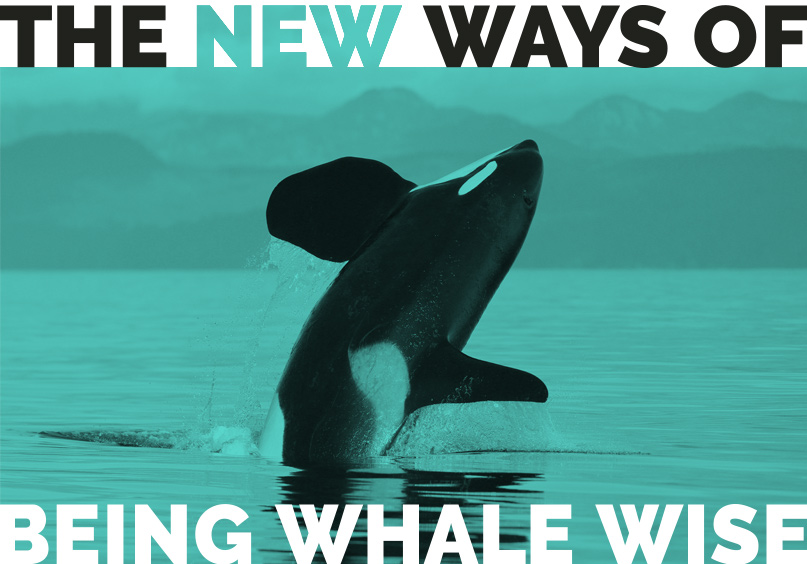
 The world at large may have been shocked, but the plight of the Southern Resident Killer Whales (SRKWs) is not news for us locals. We love our iconic Chinook salmon-eating J, K, and L pods, and just about everyone has a personal encounter to share, whether from the deck of their boat or the People’s Yacht, the ferry. As a boater, nothing brightens my day quite like a surprise visit from these majestic and intelligent animals, somehow so powerful yet stealthy, bonded to each other much like we are with our families. Yet tragic stories of dead Southern Residents have been accumulating for a few years now, and there’s hard data to back up the anecdotal evidence.
The world at large may have been shocked, but the plight of the Southern Resident Killer Whales (SRKWs) is not news for us locals. We love our iconic Chinook salmon-eating J, K, and L pods, and just about everyone has a personal encounter to share, whether from the deck of their boat or the People’s Yacht, the ferry. As a boater, nothing brightens my day quite like a surprise visit from these majestic and intelligent animals, somehow so powerful yet stealthy, bonded to each other much like we are with our families. Yet tragic stories of dead Southern Residents have been accumulating for a few years now, and there’s hard data to back up the anecdotal evidence.
According to the NOAA report Southern Resident Killer Whales 10 Years of Research & Conservation (2014), the historical minimum population, of this unique group was 140 individuals. According to the same report, the population was in the most peril during the era of captivity for marine shows in the 1960s. A sizeable portion of the world’s captive killer whales are in some way related to the Southern Resident population as mostly calves were captured from the wild during this time to be on display. The population clocked in at a 71-animal minimum in 1974 and has experienced periods of growth and decline since, almost cracking 100 again in the mid-1990s.
The trend has been a net negative since then, and now we’re in the seventies again. At the time of this writing, the community is elated to welcome a newborn—L124, Lucky—who brings the number to 74 individuals. It’s for this reason that Southern Residents are officially designated Critically Endangered under the U.S.A.’s Endangered Species Act.
Diverse opinions—informed and non-partisan as well as ill-informed and biased—abound in the public sphere of debate. Rather than dive into the melee of opinion columns and policy prescriptions, we offer this piece as a resource to locals and boaters on the recent Southern Resident Killer Whale Task Force recommendations and trans boundary guidelines and regulations with regards to being orca-wise. Regardless of the macro-level future of the region and our wildlife, being the best boaters we can be is something within our power whenever we hop aboard. As Mahatma Gandhi would say, be the change you want to see in the world!
If you truly want to be up to date on the issue, the full 148-page Southern Resident Orca Task Force Report and Recommendations (November 16, 2018) is available online at governor.wa.gov. Don’t let the page count intimate you too much, as there are plenty of figures, citations, and the like that you needn’t dwell on too much. For the practical among us, the Recommendations section is the key for navigating our day-to-day lives. The good stuff is on pages 67 to 70; the Overview of Recommendations (aka cheat sheet) that succinctly describes all 36 recommendations, the lead and key partners for each recommendation, and jurisdiction (state, local, federal, etc.).
Credit where credit is due, there are plenty of data-backed ideas, multi-organizational cooperation, and legislative transparency within these recommendations. There are also some redundancies and head-scratchers. Here we include all the recommendations with our practical translations that explain how our boating lives are affected. We’ve organized them by number, in the order the recommendations are listed in the overview.
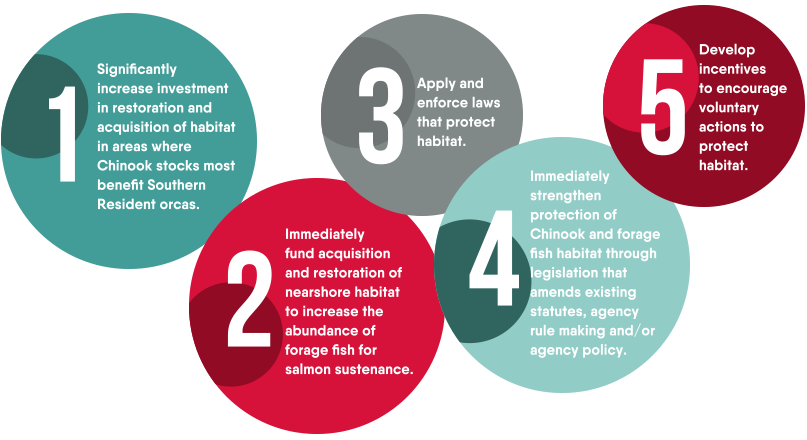
Translation:
Is it just us, or could you condense recommendations 1 through 5 as “protect salmon habitat”? For #1, wild Chinook salmon populations are in trouble, so state organizations are banding together to acquire and protect land deemed critical to Chinook stock success. If this has the desired effect, there should be more Chinook salmon for all, orcas and anglers alike.
Recommendation #2 is made in a similar spirit as the first recommendation: Wild Chinook need more habitat. Funds were already approved during the 2018 grant round, so no new tax incoming this year.
Recommendation #3 begs the question: Were we not applying and enforcing the laws previously? Regardless, more law enforcement staff are on the way, so boaters should be ready to interact with The Man more often (see #18).
Recommendation #4 also tackles Chinook salmon habitat protection but takes a legislative angle, with the squeeze aimed at aquatic and shoreline development projects and permits.
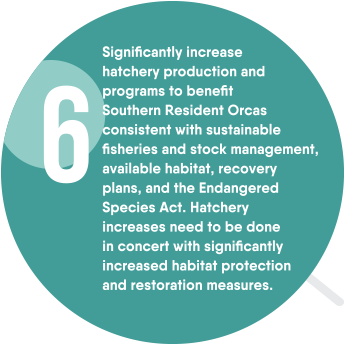 Recommendation #5: The state wants to incentivize landowners to voluntarily protect their shoreline property and rope in cooperating conservation programs for volunteer efforts. Seems like a carrot vs. stick approach. Boaters can help by peer pressuring their landlubbing property owning friends on shore to participate and staying tuned for community service opportunities.
Recommendation #5: The state wants to incentivize landowners to voluntarily protect their shoreline property and rope in cooperating conservation programs for volunteer efforts. Seems like a carrot vs. stick approach. Boaters can help by peer pressuring their landlubbing property owning friends on shore to participate and staying tuned for community service opportunities.
Translation:
Recommendation #6:Hatchery Chinook incoming! This recommendation is a big deal, especially among the fiery pro- and anti-hatchery salmon crowd. It looks like getting more Chinook in the water for the SRKWs is the primary objective, genetic purity a second.
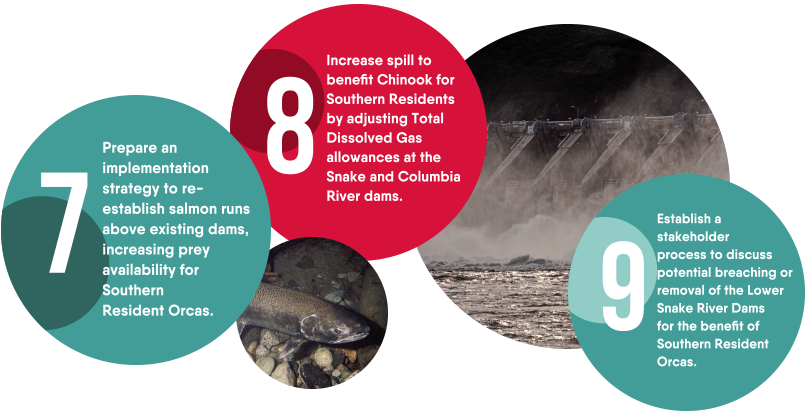
Translation:
Recommendation #7: Clearly, we’re going all-out to get Chinook back in the water, and inland waters above dams are no exception. Bear in mind that these runs are functionally wiped out, so reestablishing them would be quite ambitious and inspiring. Are more fish ladders in order?
Recommendation #8: This technical recommendation is for water quality nerds. It tweaks the parameters around dam spillage in order to get more dissolved gases (read, oxygen) into the water from 115 percent to 125 percent. Inland boaters should expect more announced dam spills on the lower Snake and Columbia rivers.
Recommendation #9: Ka-Boom!? The salmon run vs. dam struggle continues and this one is quite dramatic, literally implying that we could be blowing up dams in our near future. Updates on implementation is due by this summer, so stay tuned for some potentially epic fireworks.
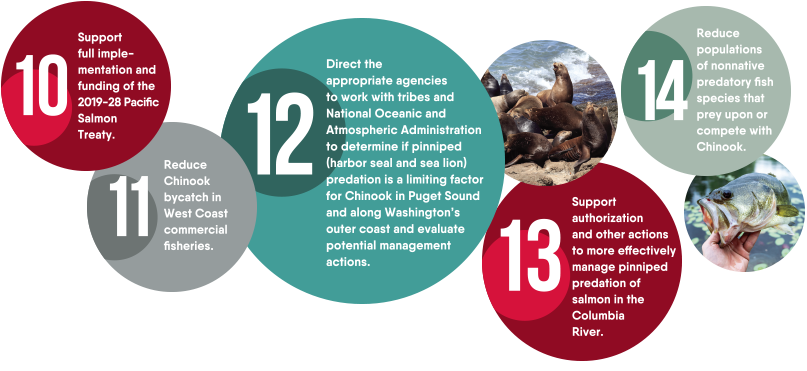
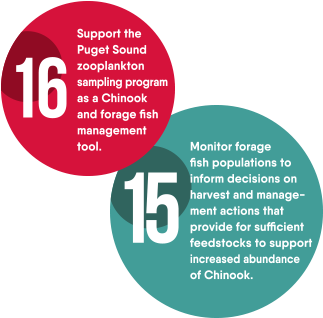
Translation:
Recommendation #10: The 2019-28 Pacific Salmon Treaty is a recent agreement between representatives from Canada, Oregon, Washington, Alaska, and Northwest and Columbia River tribes as an update to the 1985 Treaty. This treaty is a whole other feature but also begs the question: Weren’t we already supporting the full implementation and funding of the treaty?
Recommendation #11: This one is aimed at our commercial brothers and sisters. Nobody wants bycatch, especially of our precious Chinook salmon. Details on implementation of this one is vague, mostly focused on discussions with local stakeholders. While talk is a start, not a lot of action to tout on this front.
Recommendations #12 & 13: Dead sea lions. A new era of pinniped (sea lion and seal) control is upon us: one of lethal force. Both Oregon and Washington have authorized lethal removal of pinnipeds by their respective authorities. It’s worth noting that since September 2018, at least 12 sea lions have been illegally shot (according to King5 News). Again, getting those Chinook stocks up is priority one it seems. Will it work or are these animals scapegoats? Looks like we’re going to find out. Boaters should expect to see fewer sea lions while out and about.
Recommendation #14: Get the poles! If you’re a walleye, bass, or channel catfish angler, you’re looking at looser regulations. The logic is that these nonnative predatory fish prey upon young Chinook salmon, so why not give the little guys some cover fire? Do your part for the environment, catch a bass!
Recommendations #15 & 16: More salmon food. “Forage fish” is the term for fish that Chinook salmon eat (herring, smelt, and sand lace). Makes sense to look at their food source, zooplankton, too. If you go after these fish, keep your ear to the ground, for the state will be reassessing the stocks and allowed harvest levels.
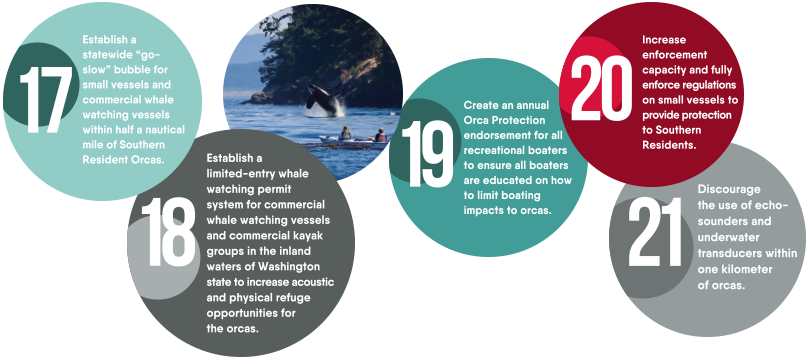
Translation:
Recommendation #17: Boaters, take note! The previous “Be Whale-Wise” recommendations from NOAA were a 400 meters/yards slow zone (slow defined as 7 knots) and a 200 meters/yards “No Go” distance. This half-mile increase means that, if you do see orcas that aren’t a blip on the horizon, you best slow down just in case. It’s worth noting that orcas are the world’s largest dolphin, not a whale, so “Orca-Wise” makes more sense. My marine science degree strikes again…
Recommendation #18: This recommendation puts the squeeze on the commercial whale watching industry via a stricter permitting process. It’s not as heavy-handed as #28 though.
Recommendation #19: Pay attention! Boaters should key into this recommendation in that it’s levelled directly toward us. Ultimately, it feels gentle as an optional $10 Orca Protection endorsement with every vessel registration. Boaters should also be ready for more public outreach on the topic of being Whale-Wise. We here at Northwest Yachting are doing our part as per this recommendation with this feature. You’re welcome, Olympia!
Recommendation #20: See recommendation #3; here come more uniformed staff. Four Washington Department of Fish and Wildlife officers to be exact. Welcome to the force, rookies!
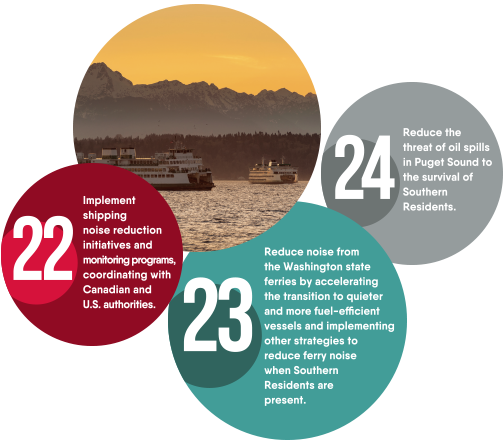 Recommendation #21: Mind those sounders! The ask from boaters is to be more cautious with our echosounder use, as orcas communicate with echolocation. Particularly, there seems to be evidence that 50-kHz transducers can be troublesome as the orcas communicate in that frequency range. If you can do so safely, turn off that echosounder when you see those black fins cruising past.
Recommendation #21: Mind those sounders! The ask from boaters is to be more cautious with our echosounder use, as orcas communicate with echolocation. Particularly, there seems to be evidence that 50-kHz transducers can be troublesome as the orcas communicate in that frequency range. If you can do so safely, turn off that echosounder when you see those black fins cruising past.
Recommendations #22 & 23: More efforts to reduce vessel noise across all segments of maritime society. Stay tuned for updates, as acoustic regulations for marine environmental reasons is still very much in its infancy as a global phenomenon.
Recommendation #24: Nobody wants oil spills, and it looks like tug escorts, oil-laden tank vessels, and the like will be taking extra precautions. Also a big deal is that this recommendation includes a call to enact legislation disallowing any shoreline or seafloor infrastructure that would support offshore and gas development off the Washington coast. Looks like the momentum for a legally drill-free coastline is gaining steam.
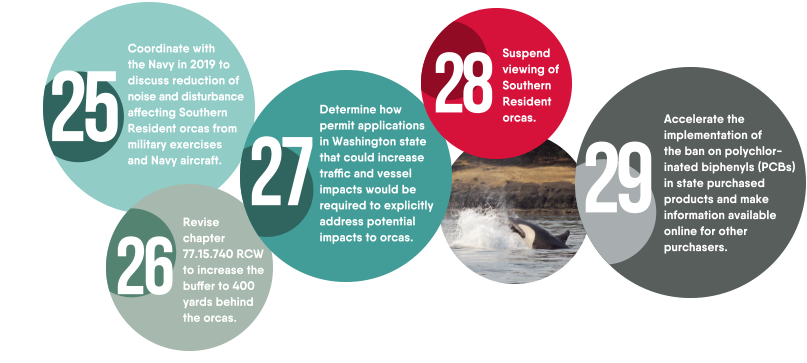
Translation:
Recommendation #25: See #22 and #23; we care about orca-harming noise. Looks like the military is no exemption.
Recommendation #26: Boaters! Remember the half-mile slowdown bubble from recommendation #17? The “No Go” distance has also been bumped up from 200 meters/yards to 400 meters/yards.
Recommendation #27: Boaters can probably relax, as this recommendation seems aimed at the governmental and industrial bureaucratic forces of the marine landscape.
Recommendation #28: Wowza! This coupled with recommendation #18 is a one-two punch for commercial whale watching companies who are now banned from purposefully viewing the SRKWs. Fortunately for those businesses, the SRKWs make up less than 20% of their viewing opportunity, and the non-endangered transient orcas are still in abundance. Still, this recommendation stands as one of the least-compromising of the lot.
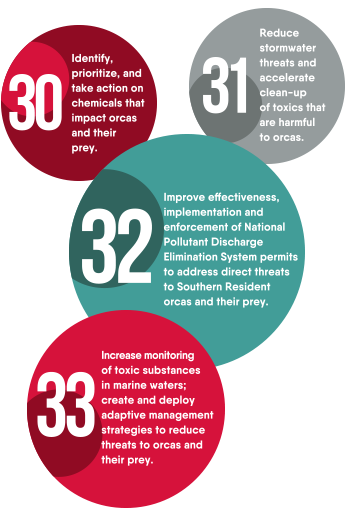 Recommendation #29: Environment-destroying PCBs are already illegal for use for Washington state agencies, but the screws are officially being tightened here. This may pertain to marine suppliers more than boaters and additional paperwork with regards to chemical information may be forthcoming for the state.
Recommendation #29: Environment-destroying PCBs are already illegal for use for Washington state agencies, but the screws are officially being tightened here. This may pertain to marine suppliers more than boaters and additional paperwork with regards to chemical information may be forthcoming for the state.
Recommendation #30: Boaters! Remember the half-mile slowdown bubble from recommendation #17? The “No Go” distance has also been bumped up from 200 meters/yards to 400 meters/yards.
Recommendation #31: Boaters can probably relax, as this recommendation seems aimed at the governmental and industrial bureaucratic forces of the marine landscape.
Recommendation #32: Wowza! This coupled with recommendation #18 is a one-two punch for commercial whale watching companies who are now banned from purposefully viewing the SRKWs. Fortunately for those businesses, the SRKWs make up less than 20% of their viewing opportunity, and the non-endangered transient orcas are still in abundance. Still, this recommendation stands as one of the least-compromising of the lot.
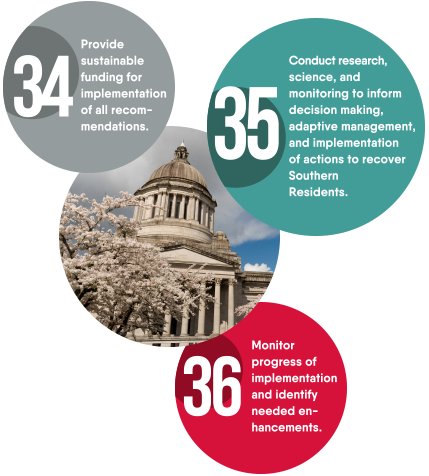 Recommendation #33: Environment-destroying PCBs are already illegal for use for Washington state agencies, but the screws are officially being tightened here. This may pertain to marine suppliers more than boaters and additional paperwork with regards to chemical information may be forthcoming for the state.
Recommendation #33: Environment-destroying PCBs are already illegal for use for Washington state agencies, but the screws are officially being tightened here. This may pertain to marine suppliers more than boaters and additional paperwork with regards to chemical information may be forthcoming for the state.
Recommendation #34: Boaters can probably relax, as this recommendation seems aimed at the governmental and industrial bureaucratic forces of the marine landscape.
Recommendation #35: Wowza! This coupled with recommendation #18 is a one-two punch for commercial whale watching companies who are now banned from purposefully viewing the SRKWs. Fortunately for those businesses, the SRKWs make up less than 20% of their viewing opportunity, and the non-endangered transient orcas are still in abundance. Still, this recommendation stands as one of the least-compromising of the lot.
Recommendation #36: Environment-destroying PCBs are already illegal for use for Washington state agencies, but the screws are officially being tightened here. This may pertain to marine suppliers more than boaters and additional paperwork with regards to chemical information may be forthcoming for the state.
Of course, there are a few ways to go above and beyond the recommendations as an orca-friendly boater. Not only should you be clued into your chart to avoid designated marine-protected and wildlife areas, but an additional voluntary No Go Zone along San Juan Island’s western shore is in effect. This area is popular for the resident orcas who feed there, and the logic is to give them an undisturbed area to do so. The No Go Zone stretches from Mitchell Bay south to Castle Point and a quarter mile offshore, with an additional half-mile zone radiating from Lime Kiln Point State Park. Any boater will tell you that it is a beautiful stretch of island paradise but consider our many other cruising options. Sometimes giving a little provides a lot, especially for an endangered orca. The choice is yours.
Additionally, drone enthusiasts should take note of a new regulation (HB 1031, Lytton Orca Drone Bill) that prohibits unmanned aerial systems within 200 yards of Southern Resident Orcas or risk a $500 fine. For most drone operators, 200 yards should be easy to accommodate.
At the end of the day, perhaps the best thing we boaters can do is to continue to cultivate a culture that gives a damn. Washington Sea Grant issues free oil spill prevention kits, so why not take advantage of that to be part of the solution?
Seattle-area chef Renee Erickson is going on a Chinook salmon hiatus for her restaurants. Whether or not you want to go that far is up to you, but the spirit is spot on. Although no recreational harvest limit has been put in place, I also plan to take a hiatus from local Chinook, the best-tasting fish on the planet. I say this as someone who has experienced the joy of reeling in blackmouth in that sweet money hole near the Kingston ferry terminal and treated my friend to a bachelor party chasing Chinook in the Sandy River in Oregon.
There’s other fish in the sea, as they say. Lucky can have mine, I’ll take the albacore. Local, sustained, and troll-caught, of course.
Read the full story on Issuu